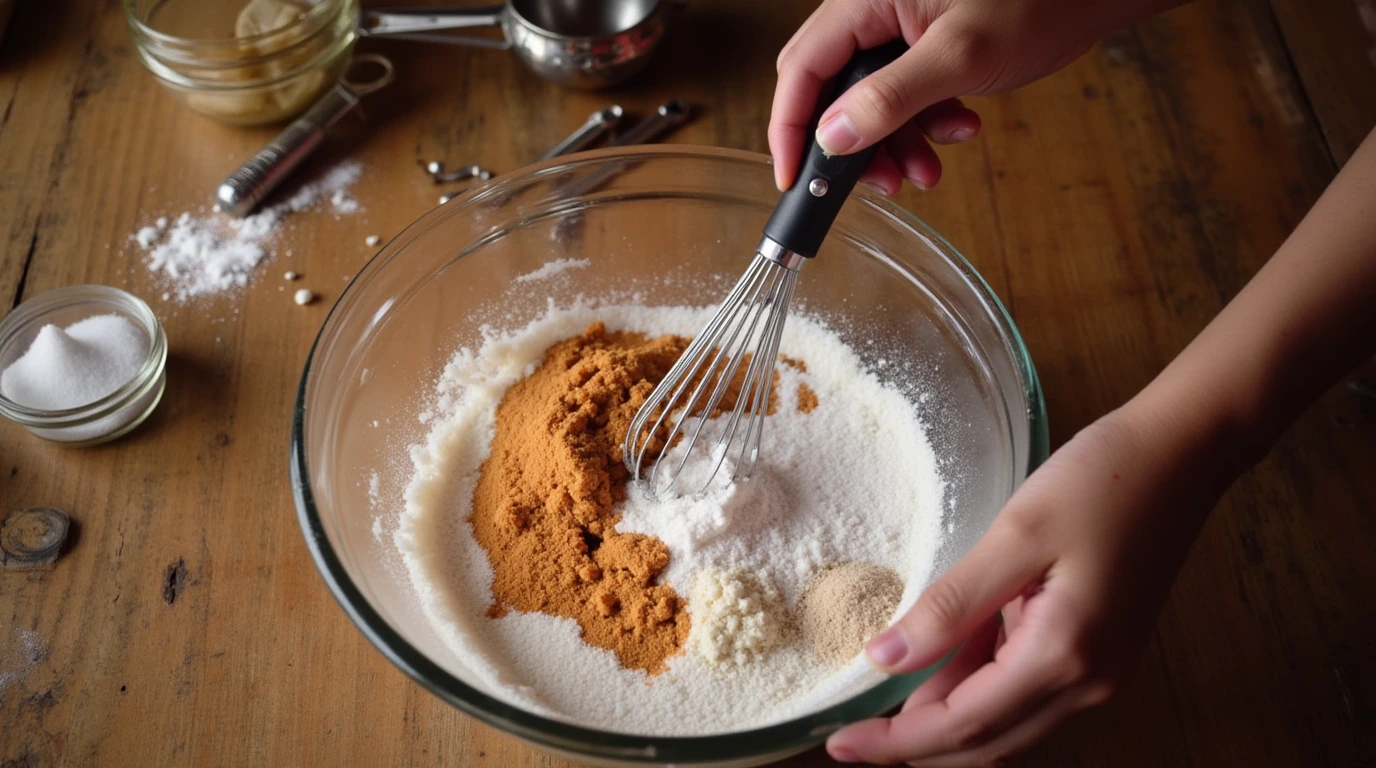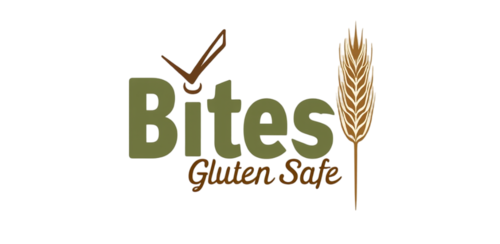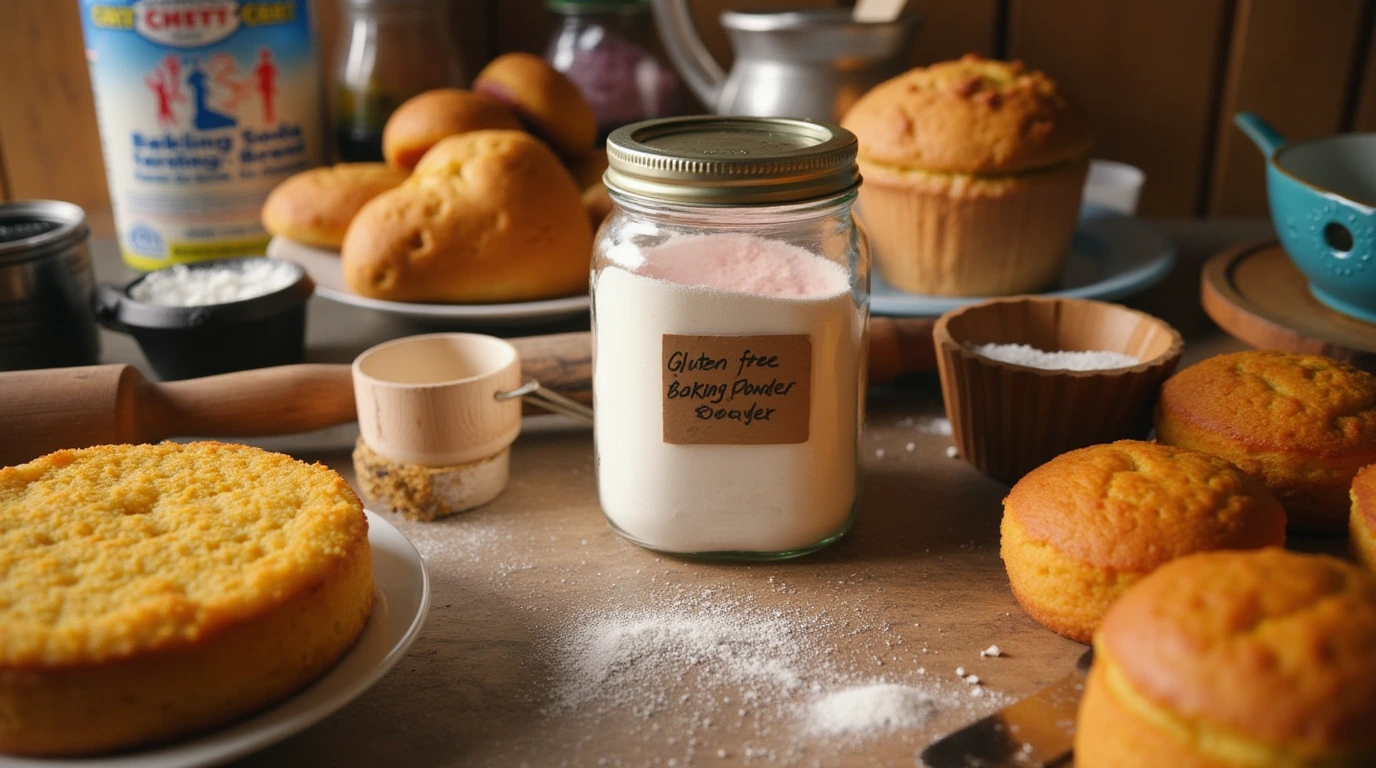Baking powder is a vital ingredient in many baked goods, providing the rise and fluffiness that make them delicious. But if you’re following a gluten free diet, you may wonder: is baking powder safe? While most baking powders are naturally gluten free, there are exceptions to consider. This guide will help you understand what to look for and how to ensure your baking powder is safe for gluten free recipes.
If you’re exploring gluten free bread alternatives, take a look at this gluten free pita bread guide to see how leavening agents like baking powder play a role in creating fluffy bread.
What is Baking Powder?
Baking powder is a vital ingredient in baking, known for its ability to make baked goods rise and achieve a light, fluffy texture. It works by producing carbon dioxide gas when mixed with liquid and heat, causing the dough or batter to expand. This reaction is made possible by the combination of three primary components:
- Baking Soda (Sodium Bicarbonate):
- The primary leavening agent that reacts with acidic components.
- Responsible for creating bubbles of carbon dioxide that help the batter or dough rise.
- Acidic Salts:
- Commonly cream of tartar (potassium bitartrate) or other acidifiers.
- These provide the necessary acidity to activate the baking soda during the mixing and baking process.
- Starch:
- Acts as a filler and moisture absorber, ensuring the baking powder remains dry and free-flowing.
- Common starches include cornstarch, potato starch, or wheat starch. This is where gluten sensitivity concerns arise, as wheat starch can introduce gluten unless specifically labeled gluten free.
How Baking Powder Works
Baking powder reacts in two stages:
- Mixing Stage: When liquid is added, the acidic and basic components react to produce carbon dioxide, creating initial air pockets.
- Heating Stage: Additional gas is released when the mixture is exposed to heat, causing further expansion and giving baked goods their structure.
Why Gluten Matters in Baking Powder
Although baking powder is inherently gluten free, cross-contamination or the use of wheat-derived starch can introduce gluten. For individuals on a gluten free diet, this highlights the importance of checking labels carefully.
Single-Acting vs. Double-Acting Baking Powder
- Single-Acting: Reacts immediately upon mixing with liquid. Recipes require quick handling and baking.
- Double-Acting: Reacts twice—once when mixed and again during baking—offering more flexibility and consistent results.
By understanding the components and reactions of baking powder, you can ensure its proper use in both traditional and gluten free baking. For instance, in recipes like gluten free cornbread or gluten free potato pancakes, baking powder plays a crucial role in achieving the perfect texture.
Is Baking Powder Gluten Free?
Most baking powders are naturally gluten free because the primary ingredients—baking soda, acidic salts, and starch—do not inherently contain gluten. However, the starch component is where potential issues may arise:
- Gluten Free Starches: Cornstarch and potato starch are safe options.
- Wheat Starch: Can contain gluten unless explicitly labeled gluten free.
For a delicious side dish that uses gluten free ingredients, check out gluten free cornbread, where baking powder contributes to its perfect rise and texture.
Gluten Free Baking Powder Options
To ensure safety, it’s best to choose baking powders that are certified gluten free. Some reliable options include:
- Bob’s Red Mill Gluten Free Baking Powder
- Rumford Baking Powder (certified gluten free)
When using baking powder in recipes like gluten free garlic bread, you can confidently create fluffy and flavorful bread by selecting the right product.
Making Your Own Gluten Free Baking Powder

For individuals with gluten sensitivities or those who prefer complete control over their baking ingredients, making homemade gluten free baking powder is an excellent option. This ensures your leavening agent is entirely free from gluten and contamination, giving you peace of mind for every recipe.
Why Make Your Own Baking Powder?
- Control Over Ingredients: You can ensure every component is gluten free and free from additives or fillers.
- Avoid Cross-Contamination: Store-bought baking powders may be produced in facilities that handle gluten. Homemade versions eliminate this risk.
- Adaptability: Customize the proportions to suit your specific recipes or dietary needs.
Homemade Gluten Free Baking Powder Recipe
Here’s a simple and effective recipe for creating your own baking powder at home.
Ingredients:
- 1 part baking soda: Provides the leavening action.
- 2 parts cream of tartar: Acts as the acidic component.
- 1 part gluten free cornstarch: Prevents clumping and ensures a smooth texture.
Instructions:
- Mix Ingredients: In a clean, dry bowl, combine the baking soda, cream of tartar, and gluten free cornstarch in the specified ratio.
- Transfer to Storage: Place the mixture in an airtight container or jar. Ensure the container is completely dry to prevent clumping or activation of the ingredients.
- Store Properly: Keep the jar in a cool, dry place. Homemade baking powder stays fresh for up to six months when stored correctly.
Tips for Success
- Measure Accurately: Use measuring spoons to maintain the correct ratios for consistency.
- Check Freshness: Use fresh ingredients, particularly baking soda and cream of tartar, for the best results. If your baking powder loses its potency, baked goods may not rise properly.
- Label and Date: Clearly label your jar and include the date it was made to track freshness.
Best Uses for Homemade Gluten Free Baking Powder
Homemade baking powder works seamlessly in a variety of gluten free recipes, ensuring optimal rise and texture. Try it in these delicious options:
- Gluten Free Pumpkin Bread: Control the leavening process for a perfectly fluffy loaf.
- Gluten Free Potato Pancakes: Achieve light, airy pancakes with this homemade blend.
- Gluten Free Pita Bread: Use it to create fluffy, perfectly puffed pita bread.
Why Cream of Tartar is Important
Cream of tartar is a natural byproduct of winemaking and acts as the acidic component in baking powder. It’s naturally gluten free and essential for balancing the alkaline nature of baking soda. If cream of tartar isn’t available, substitute it with an equal amount of lemon juice or white vinegar, though this may alter the dry-to-wet ratio in your recipe.
By making your own gluten free baking powder, you not only gain confidence in its safety but also enhance the quality of your baked goods. It’s a straightforward and rewarding step toward mastering gluten free baking.
Frequently Asked Questions (FAQs)
1. Is cornstarch in baking powder always gluten free?
- Answer: Not always. While cornstarch is inherently gluten free, the risk arises from processing. Cornstarch may be manufactured in facilities that also process gluten-containing products, leading to potential cross-contamination.
- Solution: Always check for certified gluten free labels on cornstarch to ensure it meets safety standards for those with celiac disease or gluten sensitivities. Trusted brands often include a clear gluten free certification on their packaging.
2. Can I substitute baking powder with baking soda?
- Answer: Yes, but you’ll need to pair baking soda with an acidic ingredient to activate its leavening properties. Baking soda is stronger than baking powder, so the substitution ratio is critical.
How to Substitute:
- For every teaspoon of baking powder, use:
- 1/4 teaspoon of baking soda
- 1/2 teaspoon of an acid, such as lemon juice, vinegar, or cream of tartar
This method works well in recipes like gluten free potato pancakes or gluten free cornbread, where precise leavening is crucial.
3. How should I store gluten free baking powder?
- Answer: Proper storage is key to maintaining the effectiveness of baking powder, especially in humid environments.
Storage Tips:
- Use an airtight container to keep moisture out and prevent clumping.
- Store the container in a cool, dry place away from heat sources, such as the oven or stove.
- Avoid exposure to sunlight, as it can degrade the quality of the ingredients.
4. How can I test if my baking powder is still active?
- Answer: Baking powder can lose its potency over time, especially if it’s not stored properly. To check if it’s still active:
- Add a teaspoon of baking powder to a small bowl of hot water.
- If it bubbles and fizzes vigorously, it’s still good to use.
- If there’s no reaction, it’s time to replace it.
5. Is homemade baking powder as effective as store-bought?
- Answer: Yes, homemade baking powder can be just as effective, provided you use fresh, high-quality ingredients. It also eliminates the risk of gluten contamination. A common recipe includes:
- 1 part baking soda
- 2 parts cream of tartar
- 1 part gluten free cornstarch
For recipes like gluten free pumpkin bread, homemade baking powder ensures precise control over ingredients.
6. Can I use baking powder for recipes that require yeast?
- Answer: Baking powder and yeast serve different purposes, so they are not always interchangeable. Baking powder works well in quick breads and cakes that require immediate leavening. Yeast, on the other hand, is better suited for recipes that need a longer fermentation process, such as gluten free pita bread.
7. How does gluten free baking powder differ from regular baking powder?
- Answer: The primary difference lies in the starch component. Regular baking powder may use wheat starch, which contains gluten unless processed to remove it. Gluten free baking powder uses alternative starches like cornstarch or potato starch, ensuring it’s safe for those avoiding gluten.
8. Can baking powder expire?
- Answer: Yes, baking powder has a shelf life of about 6-12 months once opened. Over time, its leavening power decreases, affecting the rise of baked goods. Always check the expiration date and test its potency if it’s been stored for an extended period.
By addressing these common concerns, you can confidently incorporate gluten free baking powder into your recipes, ensuring safety and excellent results every time.
Tips for Gluten Free Baking with Baking Powder
Successfully baking gluten free recipes requires understanding how to adapt traditional methods and ingredients to suit gluten free flours and leavening agents. Here are some tips to help you make the most of baking powder in your gluten free creations.
1. Test Freshness
Baking powder loses its potency over time, especially if exposed to moisture. Using inactive baking powder can result in dense, poorly risen baked goods.
- How to Test:
- Add 1 teaspoon of baking powder to a small bowl of hot water.
- If it bubbles vigorously, it’s still active and ready for use.
- If there’s little to no reaction, it’s time to replace it.
Pro Tip: Always store baking powder in a cool, dry place in an airtight container to extend its shelf life.
2. Adjust for Gluten Free Flours
Gluten free flours behave differently than traditional wheat flour due to their lack of gluten, which provides elasticity and structure. As a result, recipes often require adjustments to leavening agents.
- Increase Baking Powder: Start by adding an extra 1/4 teaspoon of baking powder per cup of gluten free flour. This helps compensate for the denser nature of gluten free batters.
- Combine with Binding Agents: Ingredients like xanthan gum or psyllium husk improve the structure and rise of gluten free baked goods.
3. Use the Right Mixing Techniques
- Gentle Mixing: Overmixing gluten free batters can lead to a dense or gummy texture. Mix just until the ingredients are combined.
- Room Temperature Ingredients: Baking powder reacts more effectively when combined with room temperature ingredients, ensuring an even rise.
4. Understand the Role of Baking Powder
In gluten free baking, baking powder is crucial for creating lift and texture, especially in recipes that don’t rely on yeast for rising.
- Quick Breads: Recipes like gluten free cornbread benefit from the quick leavening action of baking powder.
- Dense Batters: For denser recipes such as gluten free sourdough bread, combining baking powder with yeast can create a lighter texture while maintaining the characteristic flavor.
5. Bake Immediately
Once liquid is added to baking powder, the leavening process begins. Delaying baking can reduce its effectiveness, leading to flat or dense results.
- Tip: Preheat your oven and prepare your baking pans before mixing the batter to ensure you can bake immediately.
6. Monitor Oven Temperature
- Why It Matters: Gluten free baked goods are more sensitive to temperature fluctuations. An oven that’s too cool or too hot can affect how well they rise.
- How to Fix It: Use an oven thermometer to confirm your oven’s temperature is accurate.
7. Use Double-Acting Baking Powder
Double-acting baking powder reacts in two stages:
- When mixed with liquid.
- When exposed to heat in the oven.
This dual reaction provides a more consistent rise, especially in gluten free recipes where structure is harder to maintain.
8. Pair with Acids for Enhanced Rise
For recipes that include acidic ingredients like yogurt, buttermilk, or lemon juice, baking powder works synergistically to enhance leavening. This is particularly useful in recipes like gluten free potato pancakes or muffins.
9. Don’t Skip Resting Time
- Why It Helps: Allowing gluten free batter or dough to rest for 15-30 minutes before baking can improve hydration and help starches absorb liquid, resulting in a smoother texture and better rise.
10. Experiment and Record Results
Gluten free baking often requires trial and error to perfect. Keep notes on your adjustments to leavening agents and other ingredients to refine your recipes over time.
By following these tips, you can achieve consistent and delicious results in your gluten free baking, whether you’re making light and fluffy pancakes or dense, flavorful breads.
Conclusion
While most baking powders are naturally gluten free, verifying the ingredients and selecting certified gluten free products ensures safety for those with celiac disease or gluten sensitivity. Whether using store-bought baking powder or making your own, this essential ingredient opens up a world of gluten free baking possibilities.
Explore more recipes and tips for gluten free baking at Gluten Safe Bites.

